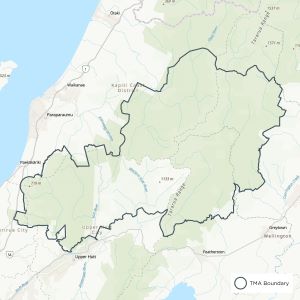Southern Tararua TB Management Area (TMA)
Pest control work planned for Southern Tararua includes aerial control.
Eradicating bovine TB in NZ
As part of our TBfree programme we deliver our pest control operations through a framework of TB management areas (TMAs). TMAs are areas with known TB infection in livestock or wildlife. Each TMA has a specific TB control plan designed to eradicate TB as effectively as possible.
 The Southern Tararua TMA
The Southern Tararua TMA
The Southern Tararua TMA includes the southern half of the Tararua Range. It also takes in the Akatarawa Valley and the adjacent hill country.
A high proportion of this TMA is in the Tararua Forest Park. To the south it also includes land owned by Greater Wellington Regional Council (GWRC), and part of this land is a pine plantation. The land to the north of the Akatarawa Valley is a water catchment area. Other than the Akatarawa Valley and the GWRC pines, the rest of the area is basically native bush. The eastern section of the Akatarawa Valley is quite populated with lifestyle blocks and houses.
A small number of predominantly meat production herds exist in this TMA.
History of TB and pest control in Southern Tararua
The Southern Tararua TMA has a long history of TB infection in cattle herds and local wildlife. In the past, we've found infected herds in the Akatarawa Valley, and infected wildlife such as pigs.
Previous possum control and livestock disease management has reduced the number of infected herds in the Wellington region. However, our monitoring has shown that we need to do further control work in the Southern Tararua area to reduce the possum population. This will:
- minimise the risk of the disease spreading through wild animal populations into farmed cattle and deer
- ensure further good progress towards eradicating TB.
The areas in this TMA have a mixed history of control. Holdsworth to Woodside Crown has had regular aerial control since the 1990s, and the Department of Conservation has completed aerial operations in the Tararua Range as part of Project Kākā. We've also completed ground control operations in the Akatarawa Valley, and GWRC has completed aerial operations there. Part of the Tararua Range has also been controlled by GWRC, but most of this area has had no control.
Current state
As of June 2025, there are no infected herds in the Southern Tararua TMA.
If you're moving animals
The Southern Tararua TMA is in the Wellington Movement Control Area. Before you move cattle or deer to another herd or farm, you must have them tested for bovine TB.
Future pest control operations
We plan our pest control operations up to 3 years in advance. The current year runs from July 2025 to June 2026.
Dates and control methods for pest control operations in Southern Tararua are provisional and subject to change. If you’re affected by any upcoming operations, our pest control contractors will contact you before work begins. They will:
- talk you through the specifics of each operation
- explain what you need to do before the operations start
- get your consent for the work to be done.
| Type of control | When | Coverage | Where |
|---|---|---|---|
| Aerial control | 2025/2026 | 32,772ha | Featherston Crown, Holdsworth to Woodside, Tararua Range South |
Map of 2025/2026 pest control operations
The proposed area for aerial control is marked on the map in yellow.
Interactive map showing Southern Tararua TB management area boundaries, Vector Control Zone, and proposed control areas.
Contacts
Rentokil Initial (trading as EcoFX) manages eradication activities in the Southern Tararua TMA. Contact them directly if you have feedback or questions about upcoming operations.
EcoFX
Phone: 07 873 8130
Email: ecofx-office-nz@rentokil-initial.com
OSPRI
PO Box 3412
Wellington 6140
Phone: 06 353 2710
Email: vector.sni@ospri.co.nz

